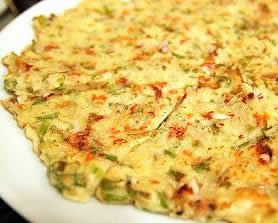Originally it was called binjatteok in the Eumsik dimibang, a cooking encyclopedia written in the 1670s by Mrs. Jang, the wife of a public officer. The dish was originally prepared by frying a mixture of water-soaked and ground mung beans, pork, bracken fern, mung bean sprouts, and cabbage kimchi. This food uses honey for seasoning, and meat was put on the bindaetteok. Rich people ate meat and poor people ate bindaetteok. Therefore, this dish was called bindaebyeong meaning poor person's pancake.
Nowadays it is eaten by all social classes of Korean because of the rich flavour in bindaetteok. And in particular on rainy days, who wouldn't want to eat hot comfort food? And it is perfect for the weather today. It is raining very hard, and it is very cold. Hot food on a cold day. What more could you ask for?
Ingredients
½ cup split mung bean
¼ tsp salt
110 g water
40 g cabbage Kimchi
20 g soaked bracken
30 g minced pork
Seasoning Sauce
½ tsp soy sauce
1 tsp minced green onion
½ tsp minced garlic
pinch of ground black pepper
2 g (½ tsp) sesame oil
50 g mung bean sprouts
3 cups water
½ tsp salt
Mung Bean Seasoning
⅛ tsp salt
½ tsb sesame oil
⅓ green pepper
¼ red pepper
⅓ ea green pepper
¼ ea red pepper
2 tbsp edible oil
Vinegar Soy Sauce
1 tbsp soy sauce
1 tbsp vinegar
1 tbsp water
Preparation
1. Wash the mung bean and soak it in water for 8 hours then drain water in a strainer.
2. Remove inside stuffs from the cabbage Kimchi, squeeze out Kimchi juice, cut the Kimchi into 1 cm-long.
3. Remove the tough area of the soaked bracken, cut into 2 cm-long, mix them with pork and season with seasoning sauce. Remove the tails of mung bean sprouts, wash cleanly.
4. Cut the green/red pepper into 1 cm-long and 0.2 cm-thick diagonally, and seed by shaking.
5. Blend vinegar soy sauce.
Method
1. Put the soaked mung bean and water into the grinder, grind them for 1 min., season with salt.
2. Pour water into the pot, heat it up for 3 min. on high heat. When it boils, scald mung bean sprouts with salt for 2 min. Cut them into 2 cm-long, season with mung bean seasoning. Mix them with cabbage Kimchi, bracken and pork together.
3. Preheat the frying pan and oil. On medium heat, make a round disk with ground mung bean into 5~6 cm diameter, and put the seasoned vegetables and pork on it.
4. Add 1 tbsp of ground mung bean over it, and top with green/red pepper. Panfry front side for 4 min. and 2 min. after turning over into yellowish pancake. Serve with vinegar soy sauce.
 Another variety is dongnae pajeon (동내파전) is named after Dongnaesung , a former fortress in the Joseon Dynasty and now a district in the city of Busan. Dongnae was a prominent battleground during the Imjin War and legend says the people of Dongrae threw green onions while defeating the invading Japanese soldiers. Dongnae pajeon was made in honor of the victory.
Another variety is dongnae pajeon (동내파전) is named after Dongnaesung , a former fortress in the Joseon Dynasty and now a district in the city of Busan. Dongnae was a prominent battleground during the Imjin War and legend says the people of Dongrae threw green onions while defeating the invading Japanese soldiers. Dongnae pajeon was made in honor of the victory.
